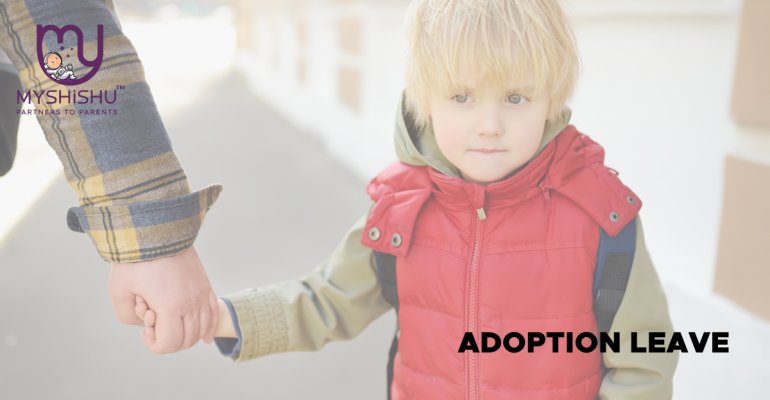Adoption Leave
Adoption Leave
Bringing a child into your family, whether through biological means or adoption, is a profound experience. For adoptive parents, this journey comes with unique challenges, particularly in balancing work and personal life. In this article, “Adoption Leave” with MyShishu we delve into the concept of adoptive parental leave, exploring its significance, the application process, and shedding light on companies that prioritize inclusivity for adoptive parents.
Table of Contents
- Understanding Adoptive Adoption Leave: A Vital Support for New Parents
- How to Apply for Adoptive Adoption Leave: A Step-by-Step Guide
- Challenges for Adoptive Parents: Adoption Leave
- Corporate Allies: Companies Leading the Way in Adoptive Parental Leave Policies
- Conclusion: Adoption Leave
- Quiz Time: Adoption Leave
Understanding Adoptive Adoption Leave: A Vital Support for New Parents
Adoptive parental leave refers to the paid leave extended to employees who are in the process of adopting a child. Recognizing the importance of this transitional phase, companies offer adoptive parental leave to empower parents, enhance productivity, and foster employee loyalty.
How to Apply for Adoptive Adoption Leave: A Step-by-Step Guide
Embarking on the adoptive parental leave journey requires careful planning and effective communication. Here’s a step-by-step guide on how to apply for adoptive parental leave:

- Research Your Company’s Adoptive Parental Leave Policy: Before initiating the application process, familiarize yourself with your company’s specific policies. Each organization may have distinct guidelines regarding the duration and eligibility for adoptive parental leave.
- Inform Your Manager Personally: Prior to submitting the formal leave application, engage with your manager personally. Discuss your plans, including the start date of your leave and potential delegation of responsibilities. This personal touch helps build understanding and support.
- Identify Responsibility Delegates: Consider the tasks and projects you’re responsible for and identify 1-2 colleagues who can manage them during your absence. Discuss this with your manager to ensure a smooth transition.
- Include All Relevant Stakeholders in Communications: When sending out your adoptive parental leave application, ensure that all relevant stakeholders are included in the communication. This includes your reporting manager, skip-level manager, human resources executive, team leads/supervisors, and your immediate team.
- Craft a Comprehensive Adoptive Parental Leave Letter: Your adoptive parental leave letter should be clear and comprehensive. Include essential details such as the start and end date of your leave, the names of individuals substituting for you, and a polite request for approval.
Challenges for Adoptive Parents: Adoption Leave
While adoptive parental leaves are a positive step toward inclusivity, adoptive parents may still encounter challenges in the corporate sector. Common challenges include:
- Lack of Legal Clarity for Children Above a Certain Age: The absence of a strict legal provision regarding adoptive parental leave for children above a certain age may result in organizations denying leaves for such cases.
- Perceived Expense of Adoptive Parental Leaves: Some companies may view offering adoptive parental leaves as costly, potentially leading to discrimination against women in a specific age group during the recruitment process.
- Alignment with Supreme Court Verdict: Many companies align their policies with the Supreme Court’s verdict, offering a 12-week maternity leave only if the adopted child is below three months. This may not consider the impact of adopting a child of any age on parents, necessitating a more flexible approach.
Corporate Allies: Companies Leading the Way in Adoptive Parental Leave Policies
In a positive shift, several companies are actively championing inclusivity for adoptive parents. Here are some corporate allies setting exemplary standards:

- P&G, India: P&G has introduced the ‘Share the Care’ policy, offering 8 weeks of fully paid parental leave for all parents, regardless of biological or adoptive status. This policy reflects their commitment to inclusivity and supporting employees in diverse parenting journeys.
- Flipkart: Flipkart’s ‘Adoption Assistance Program’ provides comprehensive benefits, including adoption allowance, extended leave options, and additional support for adoptive parents. The program demonstrates Flipkart’s dedication to fostering a family-friendly work environment.
- NDTV: NDTV stands out by offering 6 months of paid leaves to its women employees who adopt children. This commitment to providing extended leave supports adoptive mothers in transitioning into their new roles.
- Tata Consultancy Services (TCS): TCS recognizes the importance of adoptive parental leaves and offers a 3-month paid leave to adoptive parents, irrespective of their gender. This commitment reflects TCS’s dedication to creating an inclusive workplace.
- Google, India: Google, known for its progressive work culture, provides 7 weeks of paid leave to employees planning to adopt. Additionally, they offer financial assistance of up to Rs. 10,000 to cover adoption costs, showcasing their support for diverse parenting journeys.
Conclusion: Adoption Leave
Parenthood, whether through adoption or biological means, is a transformative journey. As adoptive parents navigate the intricacies of their new roles, adoptive parental leave emerges as a crucial support system. By understanding the application process, challenges, and corporate allies, adoptive parents can approach this phase with confidence.
In closing, we celebrate companies that lead the way in fostering inclusivity and supporting adoptive parents. As you embark on your journey into parenthood, may you find the support and understanding needed to thrive both personally and professionally.
Quiz Time: Adoption Leave
Question 1: What is the purpose of adoptive parental leave?
- Answer: Adoptive parental leave is provided to employees to support them in the process of adopting a child, allowing them to settle into their roles as parents.
Question 2: Why is it important to inform your manager in person before applying for adoptive parental leave?
- Answer: Informing your manager in person builds understanding and allows for a discussion on delegating responsibilities during your absence.
Question 3: What is the ‘Share the Care’ policy introduced by P&G?
- Answer: P&G’s ‘Share the Care’ policy offers 8 weeks of fully paid parental leave to all parents, irrespective of whether they are biological or adoptive parents.
Question 4: What is the key challenge adoptive parents may face in the corporate sector?
- Answer: The absence of a rigid legal provision for adoptive parental leave for children above a certain age may lead to potential discrimination against women in a specific age group during the recruitment process.
Question 5: What is the unique feature of Google’s adoption leave policy in India?
- Answer: Google provides 7 weeks of paid leave for employees planning to adopt and offers financial assistance of up to Rs. 10,000 to cover adoption costs.
Celebrate each step of your child’s journey and remember that parenting is an ever-evolving adventure. Stay tuned for more insightful blogs from MyShishu!
Explore our range of courses on new-age parenting at New-Age Parenting | Modern Parenting Styles | MYSHISHU.
For additional parenting insights and valuable information, check out our blog “Cry, Feeding and Weaning of Newborn Baby” at Cry, Feeding and Weaning of Newborn Baby – My Shishu.
Hope you’ve enjoyed the blog “Adoption Leave”. Happy Parenting!











